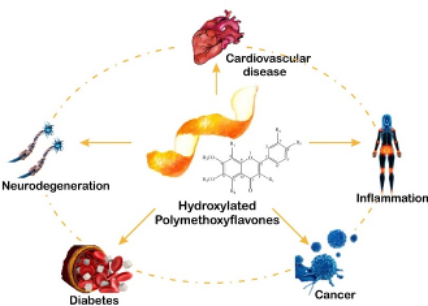
The potential benefits of hydroxylated polymethoxyflavones
Invention Summary:
Hydroxylated polymethoxyflavones (OH-PMFs), are a class of novel flavonoid compounds found in citrus plants with very low abundance. OH-PMFs could be produced through semi-chemical or semi-bio synthesis from their PMF counterparts, but the technique to generate OH-PMFs with OH substitution at 6 or 7 position is very limited. There is a need for more sustainable method to produce OH-PMFs, especially 6- or 7- OH-PMFs, at a higher yield.
Rutgers researchers have developed a method for the biosynthesis of a variety of OH-PMFs, via the cultivation of a strain of yeast found in old orange peel. Combining with an innovative dispersion method, the process can be done in aqueous solution, with a high production yield and no need of complex purification.
Advantages:
- Environmentally friendly
- Obtaining a multi-beneficial organic product by directly applying orange peel for fermentation using the new strain yeast
- Feasible for a variety of PMFs
- High yield
Market Applications:
- OH‐PMFs have potential applications in the pharmaceutical industry as pharmaceutical agents, antioxidants, colorants, and cosmetics.
- Potential therapeutic treatment for central nervous system, hyperlipidemia, obesity, diabetes, cardiovascular disfunction and several types of cancer.
- The newly obtained OH‐PMFs could be used as standards for metabolic studies of PMFs, which would allow discerning the metabolic pathways in human body.
Intellectual Property & Development Status: Patent pending. Available for licensing and/or research collaboration.